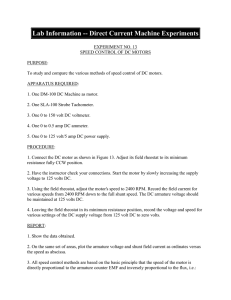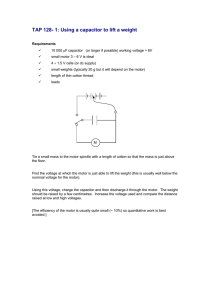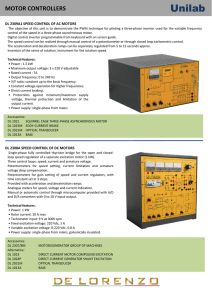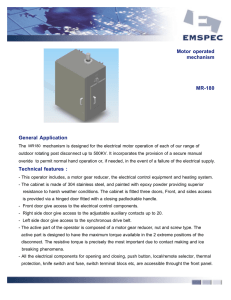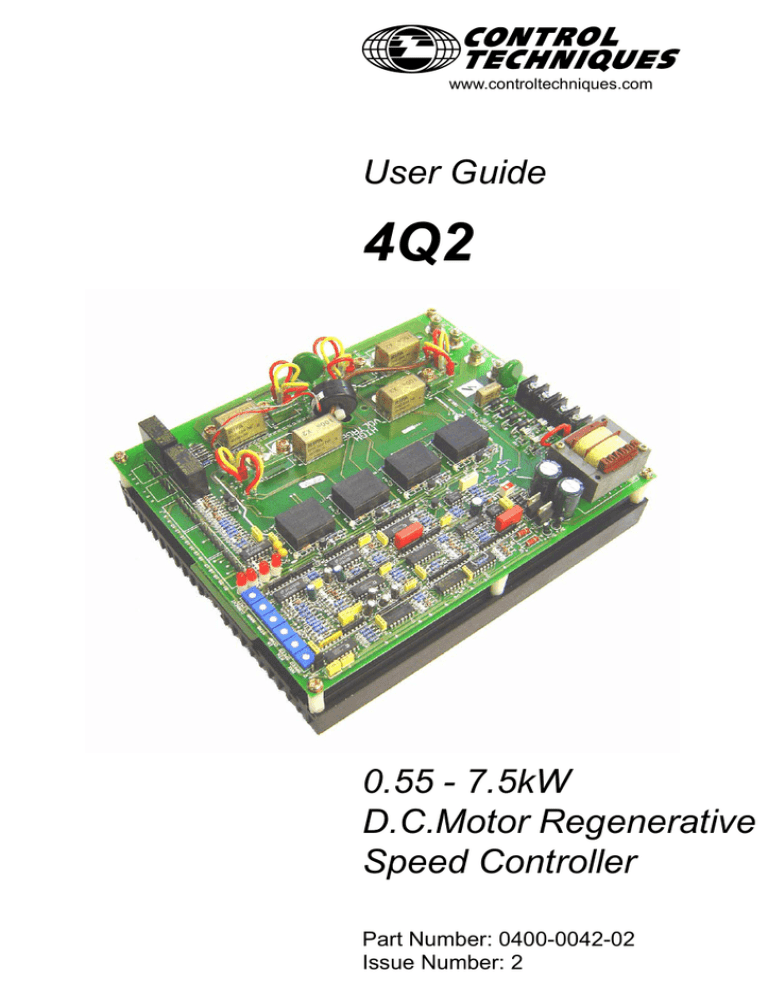
EF
www.controltechniques.com
User Guide
4Q2
0.55 - 7.5kW
D.C.Motor Regenerative
Speed Controller
Part Number: 0400-0042-02
Issue Number: 2
General Information
The manufacturer accepts no liability for any consequences resulting from
inappropriate, negligent or incorrect installation or adjustment of the optional
operating parameters of the equipment or from mismatching the variable speed
drive with the motor.
The contents of this guide are believed to be correct at the time of printing. In the
interests of a commitment to a policy of continuous development and improvement,
the manufacturer reserves the right to change the specification of the product or its
performance, or the contents of this guide, without notice.
All rights reserved. No parts of this guide may be reproduced or transmitted in any
form or by any means, electrical or mechanical including photocopying, recording or
by an information storage or retrieval system, without permission in writing from the
publisher.
Copyright
© June 2005 Control Techniques Drives Ltd
Issue Code: 2
Contents
1
General ........................................................................... 4
1.1
1.2
1.3
1.4
1.5
1.6
1.7
Description .............................................................................................. 4
Specification ............................................................................................ 4
Control inputs .......................................................................................... 5
Control outputs ........................................................................................ 5
Adjustments ............................................................................................ 6
Protection ................................................................................................ 6
Diagnostics .............................................................................................. 6
2
Installation ...................................................................... 7
2.1
2.2
2.3
2.4
2.5
Electrical .................................................................................................. 8
Mechanical .............................................................................................. 8
Motor ....................................................................................................... 9
Typical connections ............................................................................... 10
Motor fuses ........................................................................................... 11
3
Starting and Adjusting ................................................ 12
3.1
3.2
3.3
3.4
3.5
Control selection ................................................................................... 12
Switching on .......................................................................................... 13
Adjusting presets ................................................................................... 13
Reversing and braking .......................................................................... 14
Torque control ....................................................................................... 15
4
Circuit and description ............................................... 16
4.1
Power converter .................................................................................... 17
5
Fault finding ................................................................. 19
4Q2 User Guide
Issue Number: 2
3
www.controltechniques.com
1
1.1
General
Description
The 4Q2 DC motor speed controller is designed to provide full four quadrant control of
conventional shunt wound and permanent magnet motors up to 75kW capacity.
Units are suitable for operation on line-neutral supplies with 180V motors and for lineline supplies with 320V motors.
The 4Q2 incorporates isolated control circuits for armature voltage and tachogenerator
feedback modes. Alternative connection arrangements provide for both speed or torque
control with load sharing inputs and outputs available for interconnection between
master and slave units.
A simple voltage selection link selects the 220/380/415V tap on the power supply
transformer and the motor voltage is selected by a selection link allowing flexible supply/
motor voltage configurations.
The unit has both sub-cycle and delayed overload protection. With overload reset from
an externally wired N/O pushbutton, or alternatively by removing the supply to the unit
for one or two seconds.
Separate input terminals are provided for the mains power and the auxilliary electronic
supply, allowing dual voltage operation of the power and electronic circuits and allowing
the status relay to energise whilst the power circuits remain isolated.
The 4Q2 is supplied as a chassis module-IP00.
WARNING
1.2
Before selecting and fitting any links to the unit, ensure that the supply is disconnected.
Although the input and output control terminals are isolated parts of the units are live with
respect to earth.
Specification
Model
4Q2/30
4Q2/12
Average output current (A)
30
12
AC RMS input current (A)
40
25
A.C input fuses (A)
50
32
220/240V supply motor kW
4.5
1.5
380/415V supply motor kW
7.5
2.75
Typical watts loss
100
50
Motor voltage DC
V arm
V field
Supply 220/240V AC
180
190/210
Supply 380/415V AC
320
340/370
4
www.controltechniques.com
4Q2 User Guide
Issue Number: 2
Supply Voltage
220/240 or 380 or 415V AC ± 10%, 50/60Hz.
Output Voltage
0 - 180V DC armature 190/210V DC Field.
0 - 320V DC armature 340/370V DC Field.
Enclosure
Chassis mounting, IP00.
Overload
150% of continuous current for 15 seconds.
Operating Temperature
Ambient not to exceed -10 to +40°C
Humidity
85% R.H. at 40°C , non-condensing.
Altitude
Above 1000 metres de-rate by 1%/100 metres.
Control Method
Full wave fully controlled suppressed bridge with phase control, circulating current free.
Weight
3.6 kg approx.
1.3
Control inputs
Speed Reference
10kΩ potentiometer 0/± 10V
Direct speed reference - Input impedance 30kΩ
Ramp speed reference - Input impedance 30kΩ
Current reference - Input impedance 20kΩ
Run/Inhibit
N/O contact closed to run, 0 to +10V logic level.
Torque Control
Two inputs available. I/P:- 20kΩ
Speed Feedback
Single input terminal linked for either tachogenerator or armature voltage feedback.
Input impedance fixed for armature voltage feedback, must be matched to the tacho
voltage where tachogenerator feedback is required.
1.4
Control outputs
+10V, 1 mA reference supply.
-10V, 1mA reference supply.
Ramp generator output.
Speed error amplifier output (current demand).
4Q2 User Guide
Issue Number: 2
5
www.controltechniques.com
Overload Relay
Change over contacts rated for 240V at 10A. Relay energises on power up and deenergises on fault.
Low Speed Relay
Change over contacts rated for 240V at 10A. De-energise at standstill.
1.5
Adjustments
Maximum Speed
Approximately 65-100% of maximum speed.
Minimum Speed
Approximately 0-50% of maximum speed.
Ramp Speed
Approximately 0.5 seconds to 15 seconds, linear identical acceleration and deceleration
rates in both directions.
I R Compensation
Used to improve the speed regulation of the system when armature voltage feedback is
used.
Current Limit
Approximately 0-150% of maximum current.
Stability
Optimises the drive stability for differing load conditions.
Terminal Links
Speed error to current error - link terminal 14 to 15. The unit is delivered with this link
fitted.
Voltage Selection Links
Wire link for 220/380/415V supply selection. Selector link for 180/320V motors.
Speed Calibration Resistor
When a tacho generator is used to provide the feed back signal, the value of R6 must
be selected to match the maximum full speed voltage of the tacho.
There is no requirement to set R6 when armature voltage feed back is selected.
Refer to Table 3.1 Tacho scaling on page 12 for value of R6.
1.6
Protection
Individual device suppression components are fitted for each thyristor module together
with mains suppression. Adjustable electronic current limit with timed and sub-cycle
overload trip. The overload latches out and may be reset by an external push button
contact.
1.7
Diagnostics
LED indication of:
•
•
•
•
Bridge A selected.
Bridge B selected.
Inhibit (Power On but drive inhibited i.e. stand by).
Overload tripped.
6
www.controltechniques.com
4Q2 User Guide
Issue Number: 2
2
Installation
Figure 2-1
Max Speed
Min Speed
IR Comp
Stab
Ramp
Current
Limit
O/L LED
Inhibit LED
Bridge A LED
Bridge B LED
Tacho/
Armature
Feedback
Link
Control
Connections
Tacho
Selection
Resistor-R6
Motor
Selection
Link/Switch
Power
Supply
I/P
I/P Fuses
Armature Connection
Control and Field Field Connection
Supply I/P
Suitable for CE category 2 installations. If it is necessary to use the drive in category 3
installations, additional voltage suppression is required.
4Q2 User Guide
Issue Number: 2
7
www.controltechniques.com
2.1
Electrical
Ensure that the 4Q2 is completely isolated from the electrical supply before working
on the unit.
Power Cabling
Only use cable with the correct voltage and current rating. A minimum of 600V AC rating
is recommended for the power circuits.
Fusing
The 4Q2 power circuit is not internally fused, all AC feeds and armature connections
to the unit should be fuse protected.
Control Signal Cabling
All the control terminals of the 4Q2 unit are isolated from the internal power circuits.
Signal cables should be screened and earthed near to the unit. It is advisable to
segregate the signal cables from the power cables.
Overload Relay
This is a drive status relay which energises when the unit is ready to run, closing a N/O
contact between terminals 2 and 3. The overload may be reset after a trip by connecting
a N/O push button contact between terminals 20 and 21. The status contact may be
used to operate the drive contactor.
Low Speed Relay
This relay is energised when the motor speed increases above a minimum low value,
its N/O contact between terminals 4 and 5 then closes.
Motor Chokes
When specified for certain motors DC chokes must be wired in series with the motor
armature. (Refer to motor supplier).
2.2
Mechanical
The following general guidelines should be used when installing any electrical
equipment:
1. Mount the unit for best heatsink air-flow i.e. fins vertical, see Figure 22 Dimensions on page 9.
2. Mounting should be vibration free.
3. Ambient temperature should not exceed -10 to +40°C.
4. Unit should not be mounted in areas of direct sunlight.
5. Installation is free from dust, corrosive gas and grinding fluid.
8
www.controltechniques.com
4Q2 User Guide
Issue Number: 2
Figure 2-2
Dimensions
Overall width 225mm
Fixing centres 295mm
Overall height 270mm
∅ 7mm
100
56
Enclosure. Allow 50mm either side and above, and 100mm top and bottom between
unit and enclosure.
2.3
Motor
Foot mounted motors must be mounted on a level and rigid foundation and
shims used where necessary to achieve this. During installation, all ventilation
and conduit openings in the motor must be wrapped or otherwise protected
against the ingress of dirt, moisture or other foreign matter. When fitting with
couplings align the shaft to the driven machine to within ± 0.25mm.
Do not hammer couplings or pulleys on to the shaft. Before running the drive complete
the following checks:
1. With all 4Q2 connections removed, check the insulation resistance between all
windings and earth, to make sure that the machine has not suffered any transit or
storage damage.
2. Check that all brushes are seated correctly on the commutator, move freely in the
brush holders and that all brush springs are securely in position.
3. Make sure all motor ventilation openings are clear.
4. Motor chokes when specified are correctly fitted.
5. Motor rotor is free moving within the restrictions of the connected load.
4Q2 User Guide
Issue Number: 2
9
www.controltechniques.com
Typical connections
4
5
6
MINIMUM SPEED
RAMP I/P
DIRECT I/P
TORQUE I/P
TACHO
RESET
9 10 11 12 13 14 15 16 17 18 19 20 21
0V
7 8
+10V REF
+10V REF
3
F.W.D
2
R.E.V
1
0V
-10V REF
FAULT LOW SPEED
RELAY
RELAY
LINK FOR
SPEED CONTROL
Control terminal connections
INHIBIT
Figure 2-3
RAMP O/P
2.4
10k
Armature voltage feedback with forward and reverse selection, and ramped input.
3
4
5
6
MINIMUM SPEED
DIRECT I/P
TORQUE I/P
RESET
0V
TACHO
RAMP I/P
9 10 11 12 13 14 15 16 17 18 19 20 21
+10V REF
7 8
INHIBIT
+10V REF
2
10k
1
0V
-10V REF
FAULT LOW SPEED
RELAY
RELAY
LINK FOR
SPEED CONTROL
Control terminal connections
RAMP O/P
Figure 2-4
T
Tacho feedback with bi-directional control from the speed control potentiometer, with
direct input of reference signal (i.e. no ramp).
Figure 2-5
L2/N
Power connections
L1
F1
F2
A1
A2
L1
L2/N
A
FIELD
220/240V 50/60Hz
380V
415V
10
www.controltechniques.com
4Q2 User Guide
Issue Number: 2
2.5
Motor fuses
It is recommended that high speed fuses should be fitted in the armature leads.
I2t value should be <900 A2s.
Suitable types of fuses are detailed below:
Table 2.6
Fuse Manufacturer
4Q2
IR
GEC
FERRAZ
GOULD
12A
E1000-20
GSG-1000/16
CPURE 20A
A25X1-20
30A
E1000-40
GSG-1000/40
CPURE 40A
A25X1-40
When used with 180V motors, fuses of a lower voltage rating may be able to be used,
consult fuse manufacturer for alternatives.
4Q2 User Guide
Issue Number: 2
11
www.controltechniques.com
3
WARNING
3.1
Starting and Adjusting
Although control inputs to the 4Q2 are isolated, certain areas of the circuitry are not.
Exercise extreme caution when adjusting the unit and always isolate the equipment
whilst setting voltage calibration links.
Control selection
Tacho/AVF Feedback
If armature voltage feedback is to be used ensure that the AVF link is in place on the
circuit board. If tachogenerator feedback is required then reset this link to TG and
connect the tacho between terminals 7 and 12. The unit is feedback polarity
dependant and hence only true DC tacho may be used. The tacho voltage must be
arranged to be of opposite polarity to the reference voltage. If it is not possible to
establish the tacho polarity then ensure that the maximum speed preset is turned fully
anti-clockwise before switching on. Failure to observe this precaution could result in
the motor running into overspeed before the controller has been fully set up. When
used with a tacho generator the feedback signal must be correctly calibrated to suit the
voltage produced by the tacho at maximum motor speed. This is achieved by selection
of resistor R6.
This resistor can be selected using the table below:
Table 3.1 Tacho scaling
Tacho volts at max.speed
R6 value
20
22k
40
47k
60
68k
120
130k
180
200k
Speed/Torque Control
For normal operation as a speed controller, a link should be fitted between terminals 14
and 15. where torque control is required this link should be removed and the torque
(current) reference signal input at terminal 16. The 4Q2 will produce zero to full load
current in both directions, under control of the current limit potentiometer, depending on
the direction and level of the current reference signal. The current limit potentiometer
may be used to limit the range of control available from the external current control
element, the overload circuits will continue to operate in the normal manner if the final
current demand exceeds 110% of the maximum current of the unit.
12
www.controltechniques.com
4Q2 User Guide
Issue Number: 2
Voltage selection link LK2
Motor voltage is selected by sliding the jumper-switch LK2 into the appropriate position.
Figure 3-2
LK2 Switch
Link position
for 320V
180
320
180
320
Link position
for 180V
Line supply voltage selection
The voltage selection link adjacent to the transformer on the board must be set to the
correct voltage position.
NOTE
3.2
It is essential that the supply to terminals L1-L2/N on the unit are maintained in phase
with each other, although they do not necessarily have to be of the same potential.
Switching on
Before switching on ensure that the supplies to terminals L1-L2/N are in phase,
reversal of phases will cause the unit to malfunction.
During initial switch on it is advisable to inhibit the controller by disconnecting the feed to
terminal 11, this will inhibit the controller and prevent energisation of the motor until the
preliminary checks have been carried out.
When power is applied to the 4Q2 the inhibit LED and one of the bridge selection
LED’s should illuminate.
Set the current limit potentiometer almost fully anti-clockwise (zero current) and make
the connection to terminal 11. The inhibit LED should extinguish, apply a small speed
reference signal from the speed control potentiometer.
The motor will start to turn and it's speed will increase until it matches the level set by
the speed control potentiometer. If the unit is being used on armature voltage control the
feedback polarity will be correct and control will be attained.
Where a tachogenerator is employed, the motor may continue to accelerate with no
control. If this is the case shut down and reverse the tachogenerator connections. If it is
necessary to reverse the direction of rotation of the motor, remember that the tacho
polarity must be reversed at the same time.
Once satisfactory operation has been achieved, adjust the speed reference level and
check that the motor speed increases and decreases in response to changes in the
speed reference setting.
3.3
Adjusting presets
Maximum Speed
With the speed reference signal at maximum, adjust the maximum speed potentiometer
to set the motor running at the required maximum speed. Ensure that the maximum
motor armature voltage is not exceeded otherwise the unit will trip out. If the correct
speed cannot be attained by adjustment of the maximum speed potentiometer, then
4Q2 User Guide
Issue Number: 2
13
www.controltechniques.com
check the value of R6 has not been correctly matched to the tachogenerator voltage.
If the motor speed is too high then the value of R6 must be reduced and conversely if
the motor speed is too low then the value of the resistor should be increased.
Minimum speed
With the speed control potentiometer set at zero adjust the minimum speed
potentiometer to set the required minimum speed.
NOTE
If the main speed setting potentiometer is connected directly between the positive and
negative reference supplies then the minimum speed potentiometer cannot be
configured into the circuit.
Current limit
This is used to set the maximum current which the motor can draw from the controller.
Setting the potentiometer fully clockwise will provide up to 150% of the calibrated
controller maximum current. (Either 18A or 45A).
The overload threshold is approximately 110% of this calibrated value and operation for
prolonged periods at current levels above this figure will cause the unit to trip.
To reset the overload circuit and re-enable the status relay a normally open pushbutton
should be connected between terminals 20 and 21, or the power to the unit may be
removed for 1 or 2 seconds.
Ramp control
A single rate ramp generator is provided to set the acceleration and deceleration rates
for the motor, the range is from 0.5 to 15 seconds. Clockwise rotation of potentiometer
gives a faster acceleration rate i.e. reduces the time.
IR Comp
IR Comp may be used to improve the speed regulation of the motor against load when
armature voltage feedback is used. To set up, the speed of the motor must be checked
on no-load and full-load, the IR Comp potentiometer may then be used to reduce the
speed droop as load is applied. Excessive IR Comp will cause the controller to become
unstable.
When a tachogenerator is used the IR Comp potentiometer should be set fully anticlockwise.
Stability
This potentiometer sets the response of the controller. It should be adjusted to give a
smooth but rapid response to changes in speed demand. Generally low frequency
oscillations require anti-clockwise adjustment.
3.4
Reversing and braking
Because the 4Q2 is capable of controlling the motor in all four quadrants of operation,
no additional equipment is necessary to achieve reverse operation or braking either to
standstill or a lower speed. All reversing and braking operations can be performed
directly under the control of the 4Q2 unit.
Reversing is simply achieved, by reversing the polarity of the speed reference signal.
Braking is performed by reducing the speed reference signal to the new required
value, be it zero or some low intermediate setting. The 4Q2 will automatically reduce the
motor speed to the required level by changing bridges to pass regenerative current until
the new speed is reached.
14
www.controltechniques.com
4Q2 User Guide
Issue Number: 2
3.5
Torque control
Because the armature current (torque) is exactly proportional to the voltage input at
terminals 15 and 16, it is very simple to implement torque control on the 4Q2. A torque
setting potentiometer should have its wiper connected to either of these inputs, bidirectional torque reference signals are accepted by the 4Q2.
External control of the current limit level is also possible by replacing the wire link
between terminals 14 and 15 with a potentiometer connected as a potential divider to
terminal 7 or 20 (0V).
4Q2 User Guide
Issue Number: 2
15
www.controltechniques.com
4
Circuit and description
Figure 4-1
Block diagram
16
www.controltechniques.com
4Q2 User Guide
Issue Number: 2
4.1
Power converter
1. Power converter
Four dual thyristor modules are configured to form two fully controlled bridges, these are
connected in anti-parallel. Each module is provided with an RC network to provide dv/dt
protection and a varistor is connected across the incoming supply to suppress
excessive transient voltages.
Motor current is monitored by an AC current transformer and armature voltage
feedback is provided by a high impedance isolating circuit consisting of high impedance resistor network and buffer amplifier.
The thyristors are triggered by four dual secondary pulse transformers. The pulse
transformers generate continuous DC block firing pulses so ensuring positive
conduction of the thyristor under all conditions of rectification and inversion.
2. Power supplies
Power for the electronic control circuits is supplied via the input transformer. The
transformer has two centre tapped secondary windings providing a 100/0/100V
synchronising signal for the thyristor trigger control circuits and a 20/0/20V supply
rectified to produce an unregulated positive and negative 20V supply voltage regulators
reduce these to produce stabilised positive and negative 15V supplies for the amplifier
and logic circuits.
3. Phase control
The output from the thyristor converters is adjusted by phase angle control.
Two voltage comparators produce anti-phase firing signals when the DC level from the
current control amplifier corresponds with the instantaneous value of the cosine
synchronising voltages.
The firing signals are steered by the steering logic and combined with a master
oscillator frequency. The resulting signals then pass to the pulse transformer drive
amplifiers. These amplifiers consist of pairs of complementary transistors connected to
drive the pulse transformer primary winding with a high frequency AC square wave.
4. Speed control
The speed reference signal may be obtained via the ramp or fed directly to the speed
error amplifier via terminal 18. The speed feedback signal is selected by a link for either
tachogenerator or for the armature voltage monitoring signal.
The speed feedback voltage is calibrated by resistor R6. The speed control amplifier is
a high gain amplifier giving accurate control of the motor speed especially when a
quality tacho is used. A resistor and capacitor network provides the stabilising term
which is adjusted for optimum effect by the stability potentiometer.
The output from the speed control amplifier is reduced to zero when the drive clamp is
applied.
5. Bridge selection logic
In order to achieve four quadrant operation the thyristor converter bridges must be
selected depending upon the polarity of the speed error signal produced by the speed
control amplifier. This reflects the required direction of current flow. A speed error
polarity detector switches between two states, maximum positive or maximum negative.
A diode is connected in series with the AC current transformer monitoring motor
current. Any current flowing to the motor causes a volt drop across this diode, providing
a very sensitive zero current detector. The volt drop is amplified to a logic level, so
allowing the change in speed error polarity to be registered by the direction latch which
flips between positive and negative output only if the current is at zero, hence bridge
4Q2 User Guide
Issue Number: 2
17
www.controltechniques.com
change over is inhibited,until zero current has been registered, at this point the active
bridge is disabled and after a short delay the opposite direction bridge is enabled.
Immediately current flow recommences, the direction latch input is switched off again.
6. Overload protection
Both inverse time and instantaneous overload trips are incorporated to immediately trip
the controller and disable the status relay in the event of a fault.
The inverse time overload operates by monitoring the current demand level and
comparing it against a preset threshold. If this level is exceeded then a voltage is
produced which will start to rise at a rate proportional to the excess of current demand.
When the voltage reaches a set voltage it de-energises the status relay. The
instantaneous overload monitors current level directly, any excessive fault current bypasses the inverse time overload circuit and instantly causes a trip. This is latched and
holds the status relay out until reset.
7. Test instrumentation
Take care when connecting test instruments, although the control inputs of the 4Q2
are isolated, power circuits are not. Remember also that neither the 4Q2 output
voltage or current are pure DC. This can give misleading results when using certain
test instruments, in general though an electronic voltmeter will give reliable output
voltage readings. Current readings taken from the AC supply will vary considerably
from DC readings taken in the armature circuit. The relationship between the two
varies with speed setting. Consequently when establishing motor load conditions it is
best to measure DC armature current. A conventional "clip-on" test ammeter cannot be
used for measuring the DC circuits; only use a true DC ammeter such as a Hall Effect
probe.
18
www.controltechniques.com
4Q2 User Guide
Issue Number: 2
5
Fault finding
The following table is not exhaustive, but shows the general procedure to be adopted
when fault finding.
Table 5.1 Fault finding analysis
Fault
Possible cause
Action
Power on LED
fails
Supply loss.
Internal fuses blown
Replace fuses with identical type and manufacture and if fuses
blow again replace drive
External interlock open
Motor will not run
inhibit LED on
Motor runs for a
while and stops
overload LED
lights
Overcurrent LED lights
Check motor connections for short-circuit or ground fault.
Check Armature fuses. Reset if overcurrent trip occurs again.
Open circuit motor terminals reset. If fault remains replace
drive.
No speed reference
Check voltage Refs at
terminal 8 and 9.
Incorrect current limit
set
Check overload setting adjust if necessary
Motor overloaded
Check armature current with motor rating
Field circuit faulty
Motor runs at full
speed only
Drive unstable
4Q2 User Guide
Issue Number: 2
Check motor field voltage and current
Open circuit speed
control pot
Change control pot
Faulty tacho
Check tacho I/Ps
Tacho polarity incorrect
Swap tacho I/Ps
Incorrect setting of
stability pot
Adjust stability pot for optimum stability
Too much IR
compensation
Adjust IR Comp pot
19
www.controltechniques.com
0400-0042-02

